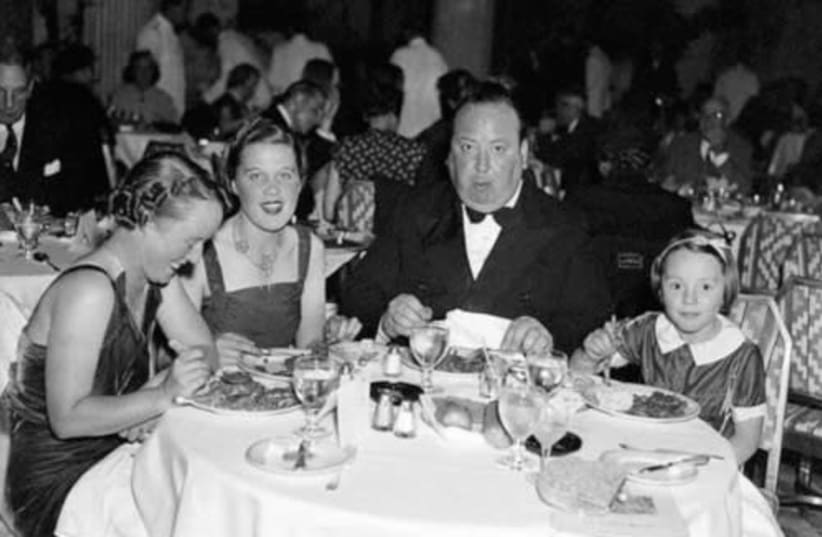Harrison is the ghost, or the titular phantom. Aside from film buffs and scholars, few know of her work. Yet Lane, chairwoman of the cinema department at the University of Miami, claims Harrison is “one of the last great untold stories of the classical Hollywood era.” Lane’s keenly observed and illuminating biography backs that assertion.
Nothing was spectral about Harrison’s life and career. Growing up in Guildford, Surrey, after World War I, she was an energetic, assertive and talented young Englishwoman. At 15, she published film reviews. After schooling at the Sorbonne, then Oxford University, she wrote short stories. She also read voraciously – mysteries, horror stories and true crime tales.
In late 1933, Harrison, then 26, answered an ad for an assistant that rising film director Alfred Hitchcock had posted. After a brief interview, Hitchcock hired Harrison to join him at Gaumont-British Picture Corporation.
While she may occasionally have poured tea for Hitchcock and jotted notes, Harrison from the start played an active role in shaping his films. A master of control as well as suspense, Hitchcock nevertheless drew upon Harrison’s keen sense of film narratives. “Her sensibilities,” Lane writes, “would help lay the foundation for Hitchcock’s overall cinematic approach.”
Working with the director’s wife, Alma Reville, Harrison bolstered the female roles in Young and Innocent (1937) and The Lady Vanishes (1938), turning the films into tales of “spirited heroines who seek adventure, truth and justice and are willing to act on their convictions.”
Hitchcock insisted Harrison stay beside him when he came to the United States. Here she challenged producer David O. Selznick to transform the heroine of Rebecca (1940) played by Joan Fontaine from a mousy naïf to an often assertive heroine. Not only did Harrison earn a screenwriting Oscar nomination that year for Rebecca, but a second nod for Hitchcock’s Foreign Correspondent (1940).
However happy Harrison was as part of the Hitchcock entourage, she struck out on her own in 1943, to produce and write screenplays. She signed on at Universal Pictures, thus becoming the first woman producer at a major studio.
Note of Harrison’s achievement suggested that stereotypes die hard. Harrison, The New York Times wrote, was “‘the only producer anywhere, with dimples and a 24-inch waistline.’”
Harrison worked almost exclusively with film noir as the form peaked in the 1940s and early ’50s. But on noir’s shadowy, rain-slicked streets, she effected a major thematic change: her scripts replaced noir’s treacherous femmes fatales with appealing, productive women. Thus, a female gumshoe becomes vital to helping clear a man unjustly accused of murder in Phantom Lady (1944).
Lane follows Harrison’s solo career, detailing the novels and stories she was drawn to and the first-rate teams she gathered to realize her visions. Lane’s analyses of performances and images in Harrison’s films – The Strange Affair of Uncle Harry (1945), Nocturne (1946), and 1947’s double shot of Ride the Pink Horse and They Won’t Believe Me – sharply delineate the films’ styles and themes.
With television eclipsing film in the 1950s, Harrison went full circle, signing on as producer of Alfred Hitchcock Presents and, in effect, importing her noir style to the small screen.
Along the way, Harrison led a personal life as alluring and mysterious as her career. She loved creating diverse images with fashion, hairstyles and makeup while pursuing equally romantic affairs. There were liaisons with actors Clark Gable and Kirk Douglas and writer Irwin Shaw. Eventually she married spy novelist Eric Ambler. An unidentified woman, though, was said to be the love of her life.
Lane’s rich portrait of Harrison virtually contradicts this book’s title. Harrison was not “the woman behind Hitchcock”; she was beside him and sometimes ahead of him. On her own, she made her own distinctive contributions to American film. Now, we have that story.
PHANTOM LADY
Hollywood Producer Joan Harrison, The Forgotten Woman Behind Hitchcock
By Christina Lane
Chicago Review Press
400 pages; $30
